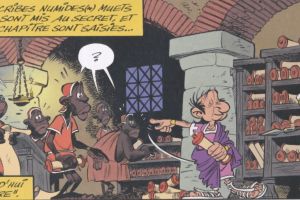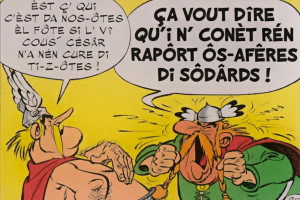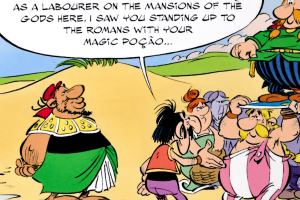Astérix in Three Walloon Dialects
Last week the third Walloon translation of Asterix in Belgium was released. Time to have a closer look. When fans think of Astérix translated into Walloon, it might be tempting to imagine a single regional edition. In reality, the publication history of Asterix in Belgium reveals a much richer linguistic tapestry. Noir Dessin Production — a Liège-based publisher known for championing regional languages — has produced not one, but three distinct Walloon translations of this classic album, each crafted in a major dialect: Liège, Namur, and Charleroi.
This trio of adaptations offers a rare and vivid demonstration of Walloon’s internal diversity. Rather than presenting Walloon as a uniform language, these editions highlight its regional depth, celebrating speech patterns that differ significantly in vocabulary, spelling, and rhythmic cadence.
Walloon: A Language of Many Voices
Walloon is best understood not as a single standardized language but as a constellation of closely related dialects. Differences among these Walloon dialects are substantial: vocabulary, verb forms, phonetic habits, and orthographic choices can vary significantly. A sentence that feels perfectly natural in one region might look foreign to readers from another—and the three Astérix editions make this linguistic diversity immediately visible. Each translation uses its own dialect’s spelling norms, local phrasing, and regional terminology. Taken together, they form a miniature linguistic tour of Wallonia.

The Liège Dialect: Eastern Flavor and Familiar Terms
The Liège dialect edition is recognizable by features typical of eastern Walloon. One well-known linguistic marker is the word “crompires” for “potatoes,” a term deeply integrated into Liégeois speech. The regional verb “djazer” appears for “to chat” or “to speak,” reflecting local usage. In this version, the character’s name is rendered as “Nicotinète,” folded naturally into Liège spelling traditions. The overall effect is a lively and familiar rhythm for readers from the area, blending longstanding Walloon features with contemporary expression.

The Namur Dialect: Central Walloon with Unique Naming
The Namur dialect version represents the central region’s Walloon. Here, the word for potatoes shifts to “bolîyes” (or “boles,” depending on context), illustrating a different etymological path from Liège’s “crompires.” Verbal structures also differ, giving sentences the characteristic cadence of Namur speech. A notable regional touch is the character’s name: in this version, she becomes the playful “Trotinète.” This adaptation reflects central Walloon naming habits, which often favor locally resonant reinterpretations of French or international names, giving the Namur dialect a unique identity.

The Charleroi Dialect: Caroloregian Forms and Western Expressions
The Charleroi dialect edition — representing the Caroloregian / Hainaut forms — shows some of the most distinctive variation. Here, potatoes appear as “peumes,” a form unrelated to both Liège and Namur equivalents. The verb for speaking appears as “d’visse,” a hallmark of western Walloon forms. Like the Liège version, the Charleroi adaptation retains the name “Nicotinète,” but spells and pronounces it according to Caroloregian norms, giving it a comfortable local feel and showcasing the nuanced differences in pronunciation between the east and the west.
A Celebration of Walloon Identity and Regional Linguistic Pride
These three regional translations are more than simple language variants. They represent a conscious effort by Noir Dessin Production to affirm Wallonia’s linguistic richness. Instead of producing a single compromise translation, the publisher chose to honor each dialect on its own terms. For collectors, these editions constitute a fascinating chapter in the history of Astérix translations. For linguists and language advocates, they provide concrete examples of Walloon’s vitality and internal diversity. And for readers from Liège, Namur, and Charleroi, they offer the distinct pleasure of hearing famous Gaulish heroes speak exactly as they do, cementing the status of Astérix chez les Belges as a truly local comic.
More information on Noir Dessin Production and its catalogue of regional-language works can be found on the publisher’s website.



A fourth translation?
The Walloon language is generally classified into four main dialects. Since Noir Dessin has already covered the Eastern, Central, and Western variants, the next logical area for translation is the Southern Walloon domain, typically associated with the Ardennes region.
The major cities and towns in this region where a translation might be localized include:
- Bastogne
- Marche-en-Famenne
- Neufchâteau
A translation focusing on the specific phonetics and vocabulary of the Ardennes area would complete the geographic and linguistic map of the major Walloon dialect groups. This dialect is often noted for having influences from the neighboring Lorrain and Champenois languages.








